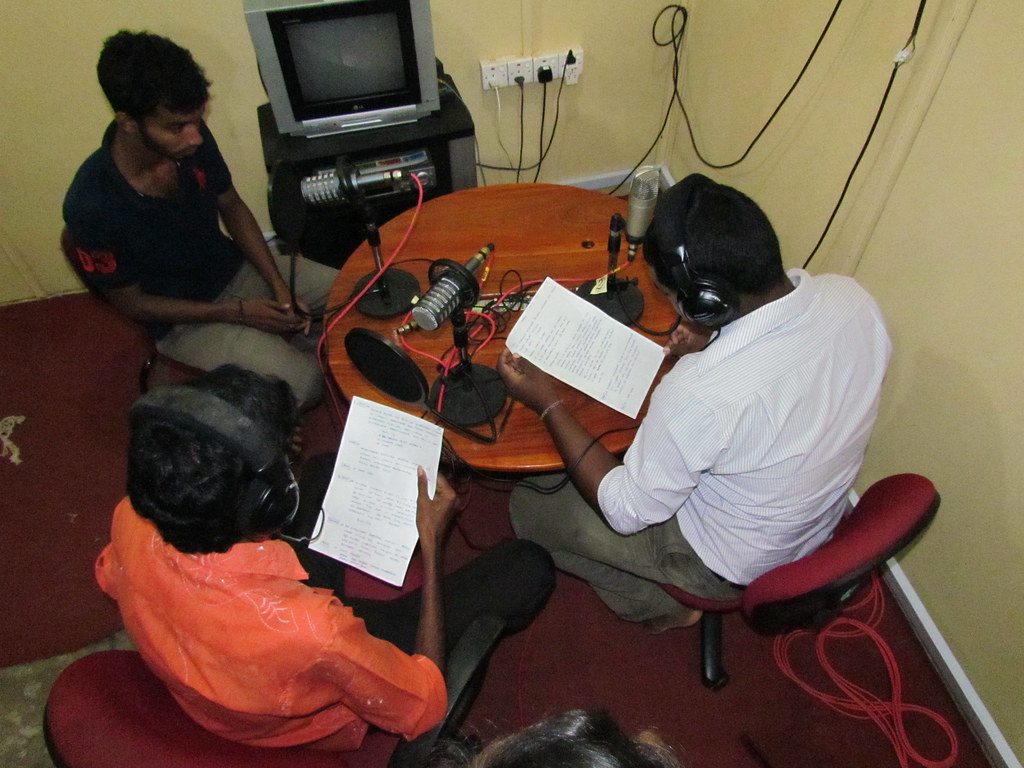
Putting together a radio news bulletin is like preparing a satisfying meal that leaves your audience nourished and prepared for the day; what you produce has to be balanced and digestible.
This training module was written for journalism students in Jaffna, Sri Lanka. They were studying broadcast journalism, and in particular creating radio news bulletins. Many of those attending the course had previously had no journalism experience or training.
Consider the listener
- You need to know who is tuning in for the information you are delivering and what they need to know. A local, region or national audience is not the same as an international audience. Each will have different needs, although all will require a mix of information. Your job is to focus on the news that is relevant to your regular listeners.
- Your top stories are not necessarily the biggest international stories of the day, although they could be. Your job, and the task of the news team you work with, is to focus on covering the issues that have the most impact on the lives of your target audience. These top stories will define how close your news organisation is to that audience.
- The audience will be listening for information that they can use. The stories you include in your bulletin must make up their staple diet of “must know” information. This story choice will reinforce your credibility as a relevant information provider in the minds of your audience. Ideally you should be stimulating a daily conversation about the issues that matter to your listeners.
- Putting the most important stories first guarantees that listeners who tune in for the start of your bulletin catch the most relevant news, even if they cannot listen to your entire bulletin.
Add variety
- Offer an information mix. Life is multi-coloured and multi-faceted, and so is news.
- If you are covering politics you must highlight how the issue affect the lives of your audience and not dwell on the politics alone. Always find someone affected by the issue and don’t just feature those in positions of power who are talking about the issue.
- If you are covering a corruption story it’s important that you talk to either the victims or carry out a vox pop in the street to try to find out what the general feeling is about the issue. Ideally, you should always try to include the voice of those affected by whatever the story is highlighting.
- Your audience will have a wide range of interests and concerns including health, education, jobs, homes, science and technology, culture, social developments, sports etc. Most of the time this means that you have to provide a mix of news, current affairs and other information items.
Your voice
- A voice that pleases is important for ensuring that the audience returns. Record a few of your bulletins and listen to them. Would you like to listen to that voice every day? If not, do something about it.
- Audio creates emotions. An attractive voice that catches the attention of the audience is important. The last thing you want is a grating voice that makes people switch off.
- Avoid the sing-song voice that plays the same tune for every sentence, going up in tone at the beginning of the sentence and then dropping down at the end regardless of what is being said.
- And never give the impression that you think you know more than the audience. There will be someone listening who knows far more than you. Never patronise.
Length
- Longer is not necessarily better. A seven-minute news bulletin is not going to be an improvement on five minutes if the extra two minutes are merely filler material.
- Try to imagine yourself in the place of the audience and think through what pressures they may be under.
- They will probably be doing other things as they listen. You are asking for their time and attention.
Speed
- Don’t rush. Make sure that your audience can understand what you are saying. Reading too quickly could result in your audience not being able to absorb the information you are sharing. You could end up becoming background noise.
- News readers often read fast when they are nervous or when they know that they are about to pronounce a name about which they are uncertain. If you know there is a foreign name coming up in the bulletin, highlight it and practice it until you are sure. Then approach it slowly, pause, and pronounce it clearly.
- A handy tip is to make a mark in your script where you need to take a breath and pause. These can help you when you come to reading the information.
Stale news
- Is your bulletin fresh, dynamic, and stimulating? Rewriting is essential. Many people will listen to several bulletins during the day.
- It’s important they are not served stale news that hasn’t been reworked. If you don’t refresh, your audience might think you are either not doing your journalistic job properly or you are being lazy.
- When you come out of the studio after reading the latest bulletin, rewrite all the top stories. Don’t just put the bulletin down and expect to pick it up again an hour later untouched and unchanged.
- If you have a news bulletin at the top of the hour and headlines on the half-hour, the headlines can’t just be shorter versions of the main bulletin. You will have to rework them and create a new headline that conveys the main point of the story and encourages people to stay tuned for the next bulletin.
- You can also use the half-hour bulletin to add stories that you could not include in the main bulletin. However, if you choose that kind of presentation format, make sure that you stick to this pattern so that your audience knows what to expect.
- Some stories could run in different formats in different bulletins. For example you could do a straight read of the information in one bulletin followed by a voice report and or an audio clip in another. Having several ways of telling the same story adds variety to your bulletin and gives you options and flexibility when constructing it.
Sound bites
- Sound bites are important. A longer news bulletin becomes a lot more attractive for the audience if you include short sound bites. This can be a five- or 10-second audio clip inserted in a voice report or a stand-alone 20- or 25-second clip.
- Such sound bites can make your bulletin easier to listen to, more authoritative (because you are including first-hand evidence) and, therefore, more credible. It’s also more interesting for the listener.
- However, all sounds have to have an editorial reason for being there. You should not fill with sound clips that distract because they don’t relate to the thrust of the information you are delivering.
Tell a short story
- Write news stories as if you were telling the story to a friend. This means: short, simple and straightforward sentences.
- The audience cannot go back and check what you said 10 seconds ago. (Well, they can if they record it or are listening online, but the majority will be listening on the move and won’t be able to rewind the bulletin.)
- You need to be clear, focused and memorable. Crafting complex information into simple sentences is a skill. Don’t obscure the essential facts with verbiage.
Effective packaging
- The bulletin should be a compilation of short but powerful stories. This format makes it easy for people to grasp the information.
- Writing for radio is one of the most challenging journalistic disciplines. The simple editorial rule about creating short, clear sentences with a subject, verb, and an object is essential.
- Don’t try to be clever with words. Use words that make the most sense and can be understood by all.
- Read through your bulletin several times. Shorten the sentences and replace complex concepts with simple terms that avoid any ambiguity or any possible misunderstanding.
Final points
- If you are putting together a longer bulletin (e.g. seven minutes or more), you may want to end the bulletin with a brief recap of the main stories. This can help audiences recall the top stories and/or other relevant information.
- If you don’t believe what you have written and what you are saying your audience won’t either; and what is more, they will not respect you for broadcasting information that anyone with average intelligence would not swallow.
- Make sure you are honest in how you describe situations and events, don’t over sensationalise. Your audience will know when you are going over the top and your credibility and integrity will be damaged if you do.

Questions
- What is the primary goal of a radio news bulletin?
- Why is it important to consider the audience when creating a radio news bulletin?
- How should a journalist preparing a news bulletin handle political stories?
- What role does the voice of the newsreader play in the effectiveness of a radio news bulletin?
- Explain the significance of the length of a news bulletin.
- How can a newsreader ensure clarity and comprehension when delivering a bulletin?
- What is the importance of rewriting news stories for multiple bulletins throughout the day?
- Describe the role of sound bites in a radio news bulletin.
- How does the text suggest news stories should be written for radio?
- What are the final points mentioned in the text regarding the credibility and integrity of a news bulletin?
Answers
- The primary purpose of a radio news bulletin is to provide a balanced and digestible mix of information that nourishes and prepares the audience for the day.
- Considering the audience is important because different audiences (local, regional, national, international) have different needs and interests, and the news should be relevant to the regular listeners.
- The text suggests that political stories should highlight how the issues affect the lives of the audience, rather than focusing solely on the politics.
- The voice of the newsreader is crucial as it creates emotions and can attract or repel the audience. An attractive and clear voice ensures the audience returns.
- The length of a news bulletin should be concise and focused, avoiding unnecessary filler material, as the audience may be multitasking and have limited time.
- A newsreader can ensure clarity by not rushing, practicing difficult pronunciations, and marking pauses in the script to maintain a steady pace.
- Rewriting news stories is important to keep the bulletin fresh and dynamic, ensuring that the audience receives updated and relevant information.
- Sound bites make the bulletin more engaging and credible by providing first-hand evidence and breaking up the monotony of a longer bulletin.
- News stories for radio should be written in short, simple, and straightforward sentences to ensure clarity and memorability, as the audience cannot rewind.
- The final points emphasise the importance of honesty, avoiding sensationalism, and maintaining credibility and integrity to ensure the audience respects and trusts the information provided.








